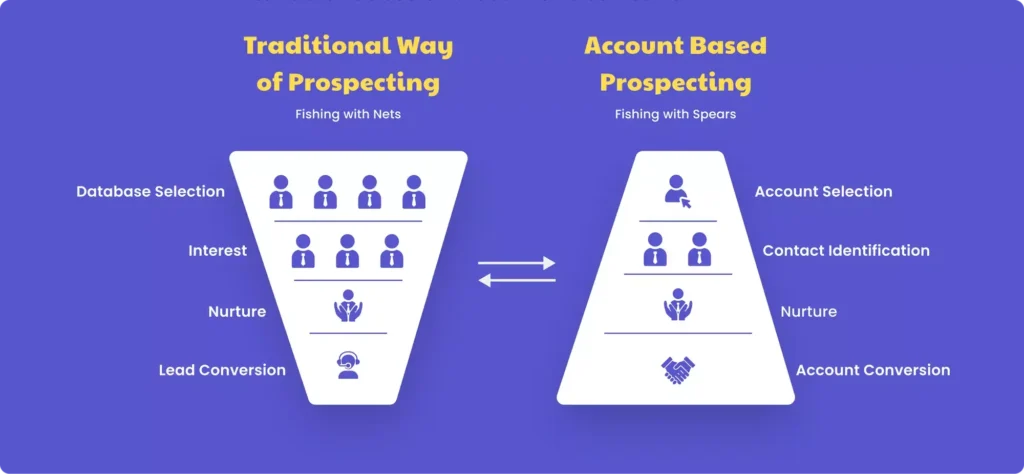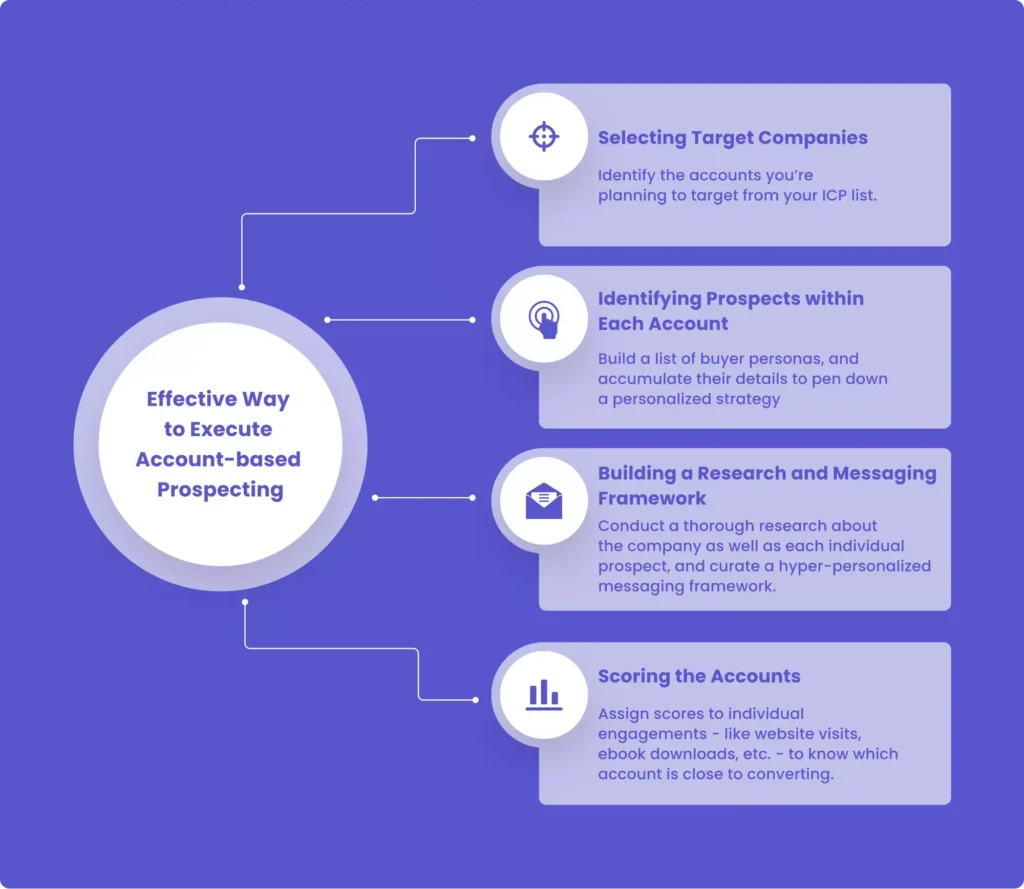The most frustrating thing for sales reps to handle is a deal falling through because they were not aware that a certain manager was not interested or a certain function did not approve the budget.
These last-minute surprises which crash deals are too much to handle because they land a huge blow in the monthly revenue target.
Most sales reps think that the deal fell through because of circumstances that were not under their control. But the hard truth is that it is the sales rep's responsibility to involve all the stakeholders responsible to close the deal in the conversation.
But sales reps follow a prospect-based outreach where they approach a single prospect in a company based on the ICP and take the conversation forward to close the deal.
There are a lot of reasons why focusing on a single prospect is not going to work anymore - there is another department for approval, the manager was not interested, the compliance did not approve, and so on. You end up playing a losing game.
The reality is, there is often more than one person involved in the decision-making process. Gartner's research says that at least 6-10 stakeholders are involved in closing a deal in mid-market companies.
So prospect-based approach can no longer make the cut. Sales reps need to change the outreach game and follow the account-based selling approach.
What Is Account-Based Selling?
Account-Based Selling (ABS) is when a sales rep does not focus on a single individual prospect in an account but rather engages with multiple stakeholders within an account simultaneously with tailored messaging for individual roles. This is exactly the opposite of Prospect-based selling.

Using account-based selling, a sales rep treats the entire company as a market of one. Reps reach out to different individuals in a single company - users, decision-makers, and other stakeholders. You spend more time researching the company and getting to know different personas, pain points, interests, and concerns.
Treating the entire company as one is how you play the account-based selling game. A game where you increase the chance of winning your high-value accounts significantly.
Benefits of Account-Based Selling
1. Consultative Selling Approach
Building trust and relationships is an essential part of the sales process. But a sales rep can do so only by learning what’s important to them and trying to add value to their day. With ABS, sales reps will take a consultative approach because they need to engage with different stakeholders using multiple touch-points and tailor content for each individual in the targeted accounts. Sales reps will prove to the prospects that they are not just trying to sell. Instead, they’re genuinely helping them solve a problem and succeed.
2. Strategic & Highly Targeted Outreach
Sales teams prioritizing prospect-based strategy mostly resort to the spray-and-pray approach, which means there is little to no personalization with generic, or worse, irrelevant messaging. With ABS, sales reps can create a framework that allows a highly targeted, multi-touch, and personalized outreach for multiple stakeholders within each account. When reps reach out with the right message which addresses the relevant pain point of each individual in an account, even if one decision-maker isn’t convinced, you’ll find others who will be interested, and eventually you will find a champion who can help you close the deal faster.
For example, you can target a CFO with messaging that highlights how your product reduces operational costs. At the same time, you can pitch how your product gives your GTM team a competitive advantage, which will be more compelling to a CEO.
3. Sales & Marketing (GTM) Alignment
Sales and Marketing teams are mostly at loggerheads about the quality of leads generated and the impact on the revenue. With ABS, both the sales and marketing teams are forced to work together instead of against each other, naturally leading to a more harmonious relationship between the two teams.
Both teams need to:
- Plan: Design the strategy to approach different accounts and stick to it
- Define leads: To avoid confusion and miscommunication, both teams need to define which accounts are to be considered, and the MQLs and SQLs
- Create content and messaging: Develop and design collaterals and messaging needed for different roles and accounts
- Review consistently: Meet regularly to set the agenda which ensures that both teams’ activities and goals are aligned
4. Predictable Sales Pipeline and High Close Rates
Generally, the pipeline value of a deal is determined only after the discovery call. This depends on the prospect revealing the right information and can be misleading for the sales rep. With ABS, sales reps know everything about the account and can predict the exact pipeline value of a particular account.
Sales reps will also be able to close deals faster because there will be no unexpected surprises of some stakeholder or decision maker not being involved and the rep would have developed a trustworthy relationship with a few individuals in the accounts.
A Framework to Effectively Execute Account-Based Selling
Here is an effective 4-step framework to successfully implement an account-based selling strategy:

1. Selecting Target Companies:
The first step in executing a successful account-based selling strategy is to choose the list of companies you want to target. This list could be a catalogue of Fortune 500 companies or companies who have raised 2 rounds of funding — it is entirely dependant on you. But the best account selection strategy is to choose companies based on your Ideal Customer Profile.
Ideal Customer Profile (ICP) is defined as the type of customers that would be a perfect fit for the solution/service that you offer. In account-based selling, since you have to focus only on a few accounts, it is really important that the sales reps spend their time on accounts that have the highest chances of growing and hence, preventing churn.
2. Identifying Prospects Within Each Account:
After selecting the accounts that fit your ICP, it is important for sales reps to find out the members of the buying committee. Creating Buyer Personas can help you paint a clear picture of the individuals/roles in different accounts.
Buyer Personas can help you map the number of individuals you need to contact within each account and define each individual’s goals, motivations, problems, and challenges. These will help in determining the number of reps needed for each account, the messaging, and the types of collaterals required.
The different Buyer Personas you need to figure out are:
- Users: These are the individuals who are going to use your product/solution on a day-to-day basis.
- Managers: These are individuals who are responsible to guide a team of users to achieve a certain target.
- Decision Makers: These are individuals who have the final say in closing the deal.
3. Account-Based Plays - Messaging:
After identifying the individuals involved in each account, the next step is to choose the different ABS plays you need to execute. While executing them, it is important for you to make the content personalized and relevant. You need to do extensive research to create the messaging as well as estimate the different types of resources and content needed at every stage of the buyer journey.
By doing so, you have a greater chance to resonate with different personas in an account right from the beginning.
4. Scoring the Accounts:
Since multiple buyer personas within the same company are being targeted, you need to start measuring the overall engagement of the company as opposed to individual lead activity.
Here’s where you can set up a scoring system. Each activity - like website visits, ebook downloads, or webinar registrations - can be assigned a score. Based on the lead score, you can determine who is close to converting.
Team Members Needed To Execute Account-Based Selling
Account-based selling is a coordinated effort between different teams because it involves building lists, research, creating different types of content and messaging, creating sales enablement collateral, running sales campaigns, demo calls, negotiation, onboarding, and support.
The different members involved in executing a successful ABS strategy are:
- VP Sales - Responsible for managing the overall ABS strategy and ensuring that the teams achieve their goals
- Business/Sales Development Reps - Responsible for creating the sales campaigns and interacting with various stakeholders to schedule the first meeting
- Account Executives - Responsible for giving the demo, and involving all parties in the negotiation, and closing deals
- Research Analysts - Responsible for conducting in-depth research about the companies and the various stakeholders involved, and building the list required to run sales campaigns
- Marketers - Responsible for devising the messaging, creating sales enablement collaterals, and running social ads to provide air cover to sales reps
- Support Representatives - Responsible for assisting users with any problems they encounter during onboarding or while using your solution
These are the most important roles, but not the only ones. Depending on your ABS strategy, you may include relevant teams in the planning committee.
Metrics To Measure in Account-Based Selling
There are a lot of metrics that you can track, such as Average Contract Value, Account Engagement Score, Sales Cycle Time, Lead Velocity Rate, Win Rate, Open Opportunities, and Closed Opportunities.
But in general, you need to ensure you choose metrics that will cover these most important areas - Awareness, Coverage, Engagement, and Revenue Impact.
- How many stakeholders in an account are engaging with us?
- What is the awareness level of an account with our solution?
- How many sales-accepted leads and sales-qualified leads have been created?
- How many new individuals have engaged with us from an account?
- What is the deal velocity difference with ABS?
- Did we increase our close rates?
- Are we able to increase the engagement level of individuals in the accounts?
Tools Needed To Execute Account-Based Selling
a) Sales Engagement Platform:
Sales Engagement Platforms, like Klenty, are the most critical tool in your tech stack that will help you execute ABS with ease. The tool will allow you to group all your accounts together and map all stakeholders involved in each account, and assign owners for each account. You can also execute multi-channel sales campaigns (using emails, calls, LinkedIn, and texts) with different messaging for different stakeholders and track engagement at an account level. You will also be able to score the accounts and uncover patterns regarding what activities lead to results, and replicate them.
Tip - 9 critical features Klenty offers to execute Account-Based Selling
b) CRM:
This is another must-have tool to store the information of all your prospects and accounts. And you can see the progress of the prospects moving along the pipeline. There are different CRMs like Pipedrive, Hubspot, Salesforce, and Microsoft Dynamics, to name a few.
c) Analytics and Data:
An Analytics and Data tool is needed to track all the revenue metrics and gather insights. You can either use a revenue intelligence platform like Clari or an analytics tool like PowerBI to visualize data, build dashboards, and get insights.
Conclusion
Account-based selling is a successful strategy to target high-value customers because the sellers deliver highly personalized communication to different stakeholders in an account to develop trust and build relationships. ABS is the way you need to play the game to close deals faster and increase your revenue.





